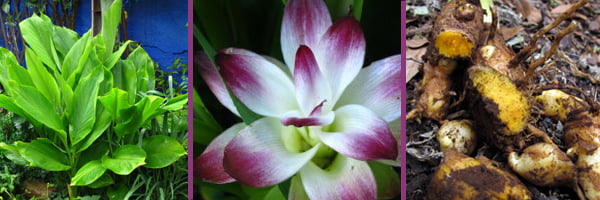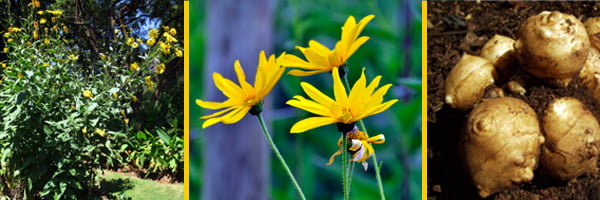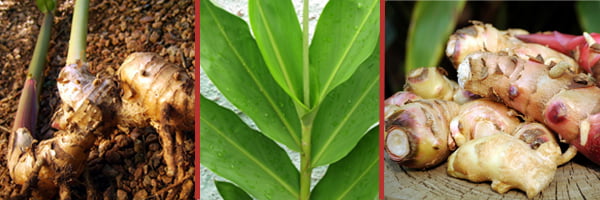May is the time to harvest the earthy autumnal flavours of turmeric, Jerusalem artichokes, ginger and horseradish.
Root vegetables come from different families but all have one thing in common: growing fat, succulent roots is a luxury for them. When faced with adverse conditions, their first priority is survival. Fat roots are not top of the list as far as they are concerned. This occurs when growing conditions are nearly perfect. Only then will plants turn their energy away from survival and begin storing up extra nutrients in plump, juicy roots.
When harvesting root vegetables with leafy tops, twist the tops off immediately, otherwise the leaves will continue to pull nutrients out of the roots.

Turmeric leaves, flower and roots. Photo Jane Griffiths and Keith Knowlton
Turmeric
Similar to ginger, turmeric grows from a tuber which spreads underground. Buy fresh root from an organic market or nursery and plant in fertile soil in a sheltered, sunny spot. It’s a tropical plant and in colder areas its strappy leaves die back if frosted. Cover with a thick layer of compost and it will pop up again in spring.
Harvest the roots in the autumn of its second year.
Both an anti inflammatory and antioxidant, turmeric has been used for centuries in India as a culinary and medicinal herb. Turmeric contains curcumin, which boosts the immune system, reduces joint inflammation and stiffness, and maintains healthy digestion. Curcumin is best absorbed when heated slightly in oil or mixed with black pepper.
Horseradish
For more than three centuries horseradish has been used for everything from relieving back pain to an aphrodisiac. It’s a perennial member of the mustard family and both its roots and leaves are edible.

Horseradish leaves, flower and roots. Photo Jane Griffiths and Keith Knowlton
Horseradish grows best in moist, well-drained soil, in full sun to dappled shade. It can be invasive if left unharvested. Grow in spring from seedlings or fresh root. Choose a piece of root about 20cm long and about as thick as a pencil. Bury it at an angle with the narrow end 10cm deep and the thicker end 5cm below the surface. Keep it well watered until shoots appear.
Leave it for the first season to build up its root system. Once big enough, it will spread its roots underground and new shoots will start sprouting around the base of the plant. In frosty areas, the leaves will die back during winter but new shoots will come up in spring. Harvest roots in early winter or after the first frosts have passed. After harvesting, leave a few roots in the ground for next spring.
Pick young leaves for salads and stir-fries. Fresh roots make a far stronger horseradish sauce than any commercial varieties. Wash the roots and trim off any green ends. Blend until the horseradish is finely chopped. If necessary add a few teaspoons of water to help it along. Be careful – cut horseradish is far stronger than any onion, so keep your face away from the bowl. For every 3 tablespoons of chopped horseradish, add 1 tablespoon of white wine vinegar, 1 teaspoon of sugar and a pinch of salt. Blend until smooth. Decant into sterilised bottles, seal and store in the fridge for up to 6 months.
Jerusalem artichokes
Despite its name, this vegetable has nothing to do with either the globe artichoke or Jerusalem. It is a member of the sunflower family and when it was first discovered in Europe, it was called girasole, the Italian word for sunflower. Over time, this became anglicised to ‘Jerusalem’.

Jerusalem artichoke leaves, flower and roots. Photo Jane Griffiths and Keith Knowlton
Jerusalem artichoke is grown from root cuttings and these are usually only available in autumn and winter from select greengrocers.In early spring, a few days before planting, cut them into pieces, making sure each piece has a growing point. Bury them about 7.5 cm deep in loose, fertile soil. Keep the area moist until the seedlings appear. They are tall plants so position them where they will not block the sun.
The plants produce better in cold-winter areas as the roots start growing fatter when the days become colder and shorter. Start harvesting the roots only after the first frosts, as they are sweeter then. In dry winter areas the roots can be left in the ground and harvested throughout winter. In wet winter areas, lift them and store them in a cool dark place, preferably covered with sand.
It is far too much hassle to peel lumpy Jerusalem artichokes. I just give them a good scrub before roasting or boiling them. Another little word of warning about these tasty tubers: they make you fart – a lot!

Ginger rhizome, leaves and harvested roots. Photo Jane Griffiths and Keith Knowlton
Ginger
While it’s called ‘ginger root’, technically, the part of the ginger plant we eat is a rhizome. This is a swollen underground stem, which has small roots coming off it.Although ginger is a tropical plant, it’s easily grown in home gardens in other areas. It likes rich, well drained soil, warm weather and filtered sunlight.
Start by buying a few fresh rhizomes in spring from your local greengrocer. Look for pieces with well-developed growth buds. Dig a hole about 5–10cm deep. Place the rhizome at the bottom with the growth buds pointing upwards. The top should be just below the surface once buried. Cover with compost and press down firmly. Water well until the ground is soaked around the rhizome. Keep well watered and mulched throughout the growing season. Ginger grows about a metre high with glossy green, strappy leaves. It spreads by growing new rhizomes underground.
As soon as you see new sprouts popping up next to your main plant, you can begin harvesting. Harvest fresh rhizomes by cutting them off cleanly with a spade.
 Horseradish sauce
Horseradish sauce
Horseradish has a mighty bite – but it loses its strength very quickly. Most commercial horseradish sauce is a bland baby-food version of fresh homemade horseradish sauce. This is delicious with salmon or roast beef.
Ingredients
3 tablespoons finely chopped fresh horseradish
1 teaspoon Dijon mustard
¼ cup sour cream
1 tablespoon mayonnaise
1 tablespoon chopped chives
Method
Mix all the ingredients together until smooth and store in an airtight container.
